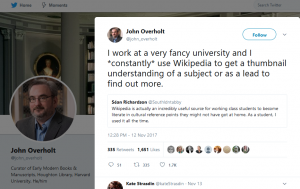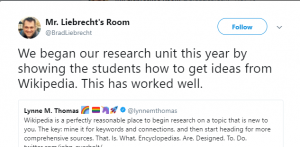Most internet searches inevitably return a result directing readers to a Wikipedia entry. If you are like most of my seventh grade students, it’s the first thing their fingers will click upon. And, if you are like many of my teaching colleagues, you will quickly redirect them to a “real” academic source.
But, increasingly teachers and scholars are understanding that Wikipedia is a “real” academic source, especially if it is used properly. Recently, John Overholt tweeted that it is a source he uses *constantly* in his work as a curator at Harvard’s Houghton Library. In fact acclaimed teachers such as Brad Liebrecht use it as a launching point for student research.

“I work at a very fancy university and I *constantly* use Wikipedia to get a thumbnail understanding of a subject or as a lead to find out more.” John Overbolt, Harvard Curator

“We began our research unit this year by showing the students how to get ideas from Wikipedia. This has worked well.” Brad Liebrect, Teacher and WSCSS Vice-President
Perhaps, then problem lies not in Wikipedia as a “non-academic” source but in that many academics and teachers don’t understand how to use this crowd-sourced knowledge tool. In order to demystify the source, let’s take a look at the Wikipedia entry for Digital Humanities.
Wikipedia users are well versed with the reader format for articles with content at the top and references down below. The content gives a general overview of the topic and the references below can provide departure points for further research. But, to stop here really only scratches the surface of evaluating a Wikipedia entry. To go further, it it important to explore both the revision history and the editors making the revisions as well as the discussion behind how that process works.
To do so, click on view history on the top right of the page. This allows you to understand when the page was created and by whom. It also tracks each edit throughout the life of the page. One can see who is adding, removing or revising content step by step. This can be a bit overwhelming, but it looking through content changes over the course a set of months or a year can make it easier to manage.
The most important feature of this revision history is learning the identities of the editors. In the case of the DH page, Elijah Meeks created it in January 2006. I can easily click on his name and discover (if I didn’t already know) that he is a digital humanities scholar. I can also evaluate the number of contributors who don’t have identifying bibliographical data to evaluate whether or not these sources seem valid, biased, etc. Meeks bows out of the creation of the article fairly early on, but his work is taken up by various other scholars such as Simon Mahony and Gabriel Bodard of the University of London’s Digital Humanities program. Bodard and Mahony “check in” on the article fairly regularly throughout its development although there are some “lurkers” who don’t seem to have biographical information or exist only identified as URLs.
However, this is where the talk feature comes in handy. Not only are we able to track edits and who is making them, we can also track the chatter around how and why those edits are happening. For example, Elijah Meeks writes at the article’s inception on January 31, 2006, that, “I figured I should start this, since no one has.” And, in a series of contributions by unsigned users in 2014, it is evident that the edits are being made by a group of digital humanists at a meeting exploring collaborative editing.
The talk feature also allows users and editors to collaborate about what to add or to request clarifying information. While there was some initial discourse in the talk session about how to define DH and whether or not to combine it with the definition of digital computing, the discussion was fairly straightforward and civil. Given the difficulty of defining DH, the article does a reasonably good job of painting a broad definition of DH and explaining the history of the discipline’s ever-evolving boundaries and the controversies/conflicts between digital and traditional scholarship.
However, the most interesting portion of the talk feature is a recent debate about the inclusion/removal of articles by a contributor for which there was some question regarding self-promotion of articles for which he was being compensated in some form. Reading through the talk leads me to believe that the issue was a bit more nuanced than the Wikipedia editor who removed the articles understood. However, because of the ability to look at the revision history, I was able to investigate these claims and authors. This seems to be a case of an aggressive editor highlighted in the Slate article Wikipedia Frown.
One of the last sections of the Wikipedia entry on DH revolves around pedagogy. It reads:
“The 2012 edition of Debates in the Digital Humanities recognized the fact that pedagogy was the “neglected ‘stepchild’ of DH” and included an entire section on teaching the digital humanities.[5] Part of the reason is that grants in the humanities are geared more toward research with quantifiable results rather than teaching innovations, which are harder to measure.[5] In recognition of a need for more scholarship on the area of teaching, Digital Humanities Pedagogy was published and offered case studies and strategies to address how to teach digital humanities methods in various disciplines.”
This is an important point, and it speaks to the opening paragraphs of this post. While doing an extensive amount of research to vet each and every Wikipedia article would not be realistic for my seventh graders, it is reasonable for me to begin to have a conversation with them about Wikipedia and how to use it. The problem is that many teachers haven’t had the pedagogical training to understand Wikipedia much less how to teach its proper use. However, this is dangerous. Wikipedia and other forms of crowd-sourced information aren’t going away. They are going to become more and more prevalent, and it’s up to teachers to give students the time, tools and technical expertise to practice how to use them in the safety of middle school.